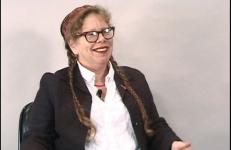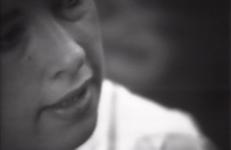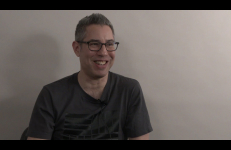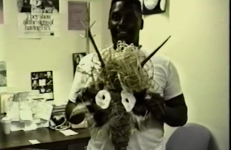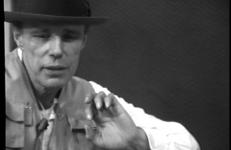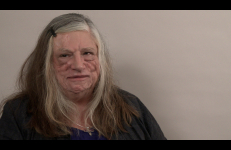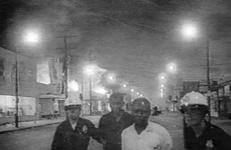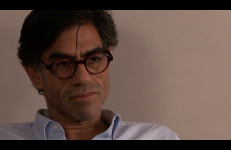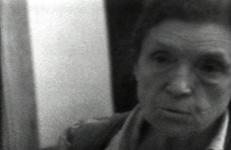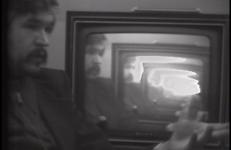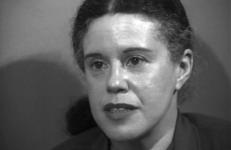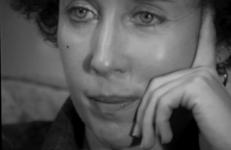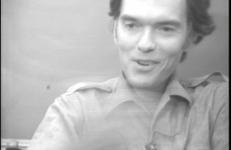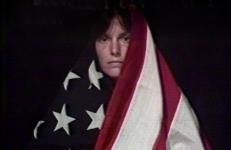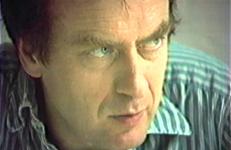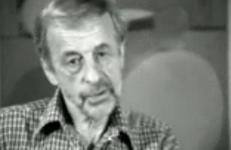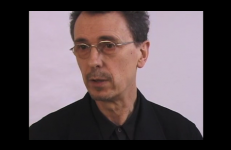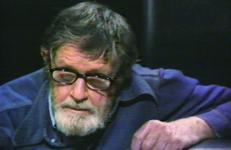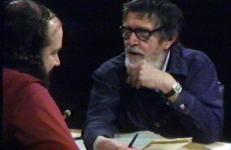In this interview, American cartoonist and author Lynda Barry (b. 1956) describes the philosophy of teaching that has inspired and mobilized her art since the 1970s. For Barry, the connection between gesture and thought collide in drawing and expose the therapeutic possibilities of art. Whether teaching undergraduate art students or prison inmates, her goal is to help others develop art making skills as an “external immune system” that will protect and monitor their emotional and mental health.
Interview
Jennifer Bartlett (b. 1941) is a writer and painter who makes large paintings with enamels on fabricated panels. She uses an overall grid structure on which she repeats images in a variety of styles ranging from lyric abstraction to childlike representation. Near the end of this interview with Kate Horsfield, she reads the chapter “Dreaming” from her book The History of the Universe (1985). “I decided: 1) I didn’t want to stretch a canvas again, 2) I wanted to be able to work on a lot of things at once. I didn’t want to exercise my own taste, which seemed boring and hideous. I wanted something modular, a constant surface."
A historical interview originally recorded in 1976, edited in 2010 with support from the Lyn Blumenthal Memorial Fund.
Glenn Belverio is an independent filmmaker and drag artist who lives and works in New York City. In 1990, he began producing and co-hosting the popular Manhattan Cable series The Brenda and Glennda Show, a talk show that mixed activism with comedy as it took drag out of the clubs and onto the street. In 1993, the show became Glennda and Friends, a post-queer task show featuring provocative co-starts such as gay pornographer Bruce LaBruce and guerrilla scholar Camille Paglia.
Bernard talks about the shield and how it protects him. The video was part of Clarke's PhD project, Journey with the Creative Process.
Between the Frames is a series that offers a glimpse into contemporary history that is already past, a portrait of personalities and opinions shaping what and how art reaches a public forum.
Joseph Beuys (1921–1986) was born in Kleve, Germany. After serving as a volunteer in the German military, Beuys attended the Dusseldorf Academy of Art to study sculpture, where in 1959 he became a professor. Much of his artwork reflects his attempt to come to terms with his involvement in the war. During the ’60s, Beuys became acquainted with the group Fluxus and artists such as Nam June Paik.
In 1964, Steina Vasulka (then Steinunn Bjarnadottir) married Woody Vasulka, a Czech engineer with a background in film. They later moved to New York where, with Andreas Mannik, they founded the Kitchen, a performance space dedicated to new media. The Vasulkas collaborated on a series of video works whose imagery arose primarily through the manipulation of the video signal at the level of the electron beam itself.
An architect and urban planner by training, Dara Birnbaum began using video in 1978 while teaching at the Nova Scotia College of Art and Design, where she worked with Dan Graham. Recognized as one of the first video artists to employ the appropriation of television images as a subversive strategy, Birnbaum recontextualizes pop cultural icons (Technology/Transformation: Wonder Woman, 1978-79) and TV genres (Kiss the Girls: Make them Cry, 1979) to reveal their subtexts.
Subtitled A Rebellion against the Commodity, this engaged reading of the urban black riots of the 1960s references Guy Debord’s Situationist text, “The Decline and Fall of the Spectacle-Commodity Economy,” Internationale Situationniste #10 (March 1966). Along with additional commentary adapted from Barbara Kruger and musicians Morrissey and Skinny Puppy, the text posits rioting as a refusal to participate in the logic of capital and an attempt to de-fetishize the commodity through theft and gift.
Gregg Bordowitz is a writer, AIDS activist, and film and videomaker. His work, including Fast Trip, Long Drop (1993) and Habit (2001), documents his personal experiences of testing positive and living with HIV within the context of a personal and global crisis. His writings are collected in The AIDS Crisis is Ridiculous and Other Writings:1986-2003.
Louise Bourgeois (1911–2010) utilized wood, metal, plaster, and bronze in creating her sculptures. Among the many themes in her work are the house (or lair), the spider and the so-called “toi-et-moi” or “you and me.” These subjects derived from a self-defined problem in Bourgeois’s life, the desire to find and express a means of getting along with other people. For Bourgeois, the relationship of one person to another was all-important, and life had little meaning without it. Louise Bourgeois’s remarkable career spanned both the modern and postmodern eras.
A major figure among underground filmmakers, Stan Brakhage (1933-2003) boasted a prolific career that spanned more than 50 years and 300 films. His personal, independent films range in length from nine seconds to several hours, and contemplate such fundamental issues as form, life, and death—most famously in Window Water Baby Moving (1959), Dog Star Man (1961-65), and The Act of Seeing with One’s Own Eyes (1971). His early writings and journals about filmmaking are collected in Metaphors on Vision (1976).
Phyllis Bramson (b.1941) is a Chicago painter whose post-imagist style emphasizes content and the deeply personal. Bramson’s paintings are private scenarios that include figures (or performers) who carry out highly charged activities with strong psychological meaning. They perform in highly theatrical, Oriental settings of almost cubist space and acid greens, yellows, and reds.
Horace Bristol discusses his long career in photography, which began with shooting for Life and Fortune magazines in the 1930s. His photojournalism took him to the Dutch East Indies and post-war Japan. His documents of Depression-era workers famously inspired John Steinbeck to write the classic The Grapes of Wrath. “I felt I was not an artist but a worker, so as a photojournalist, I had a job to do,” Bristol says.
Produced by the Fellows of Contemporary Art on artists exhibiting in a Pasadena Armory exhibition.
Los Angeles-based, Kaucyila Brooke (b.1952) makes what she describes as, "wall size photographic sequences in comic-strip format that consider lesbian relationships within American popular culture." Produced over the past five years, Brooke’s large-scale photo-text installations look at aspects of lesbian culture and alternative communities. Wry and often quite critical, they probe some of the ways lesbian relationships both challenge and reproduce the power relations and narratives of the wider culture.
California-based painterJoan Brown (1938-1990) attended the California School of Fine Arts (now the San Francisco Art Institute). Brown has long been recognized as one of the most important artists to emerge from the creative milieu of the San Francisco Bay Area of the late 1950s. She created a body of work distinguished by its breadth and personal vision. Brown’s style incorporated abstract expressionism and figurative painting. One of California's pre-eminent figurative artists, she died in at the age of 52, in India.
Roger Brown's (1941-1997) quirky, stylized paintings were influenced by such disparate sources as comic strips, hypnotic wallpaper patterns, medieval panel paintings, and early works of Magritte. His work is epitomized by a series of claustrophobic urban scenes with their drop-curtain-like gray clouds and cardboard-box apartment buildings, suggesting an amalgamation of boyish enthusiasm for model making and adult despondency. In 1996 he donated his apartment, complete with all of his belongings, artworks, writings, and automobile to the School of the Art Institute in Chicago, where it is on public display.
In this interview video and performance artist Nancy Buchanan discusses her feminist and political work. Buchanan comments upon the advantages of video over performance in terms of accessibility—the ability for her videos to circulate and reach audiences she physically cannot, and their brevity and completed form—and her strategies to create an atmosphere for change. This Video Portrait features two of Buchanan’s videos in their entireties: the anti-nuclear weapons work An End to All Our Dreams (1982) and the more straightforwardly feminist Webs (1983).
Benjamin Buchloh is an influential art critic and historian; he has written extensively on contemporary art for journals and exhibition catalogs, as well as his essay collection Neo-Avantgarde and Culture Industry (2002). This interview with Buchloh is one of several collected by Antonio Muntadas for his series Between the Frames. In this video Buchloh discusses the relationship between people and institutions.
Rudy Burckhardt (1914-1999) was best known as a photographer and filmmaker. He moved to New York from his native Basel in 1935 at age 21. He shot portraits of many artists for Art News during the 1950s and early ’60s, capturing their work methods in candid and intimate photos. His films, frequently portraying cityscapes and urban life, include The Pursuit of Happiness (1940), Under the Brooklyn Bridge (1953), What Mozart Saw on Mulberry Street (1956), Square Times (1967), and Inside Dope (1971).
Chris Burden came into prominence in the late 1960s, but unlike many of the performance artists of his generation, Burden was interested in empirical and scientific investigations. His goal was to return the control of art making to the artist and to question the relevancy of more established art practices. In this documentary Burden talks about his hard-hitting performances in the ’70s that took a jaded art world by surprise and continues on to discuss the sculptural and installation works of the ’80s.
Victor Burgin (b.1941) is known as a highly influential artist and a renowned theorist of still and moving images. After 13 years in the United States, Burgin returned to live and work in his native Britain in 2001, taking up the prestigious post of Millard Professor of Fine Art at Goldsmiths College. Burgin first came to attention as a conceptual artist in the late 1960s and at that time was most noted for being a political photographer of the left, who would fuse photographs and words in the same picture.
Photographer, theorist, and lecturer Victor Burgin lives and works in London. A Professor of Fine Art at Goldsmiths College and former Professor Emeritus of the History of Consciousness at University of California-Santa Cruz, Burgin’s work explores the semiotics of meaning in visual art. His books include The End of Art Theory: Criticism and Postmodernity (1986), In/Different Spaces: Place and Memory in Visual Culture (1996) and, as editor, Thinking Photography (1986), Between (1986) and Formations of Fantasy (1986).
John Cage’s work has had an immeasurable influence on 20th Century music and art, and his formal and technological innovations were tied to his desire to push the boundaries of the art world. In 1951 he initiated the first recording on magnetic tape, and in 1952 he staged a theatrical event that is considered the first Happening. His invention of the prepared piano and his work with percussion instruments led him to imagine and explore many unique and fascinating ways of structuring the temporal dimension of music.
John Cage’s compositions and performances have had a profound influence on generations of musicians and artists. In this tape, he initiates For the Third Time as author Richard Kostelanetz interviews him. “I’ve left the punctuation out, but I’ve distributed it by chance operations on the page, like an explosion,” Cage says. “You can replace the punctuation where you wish.”




